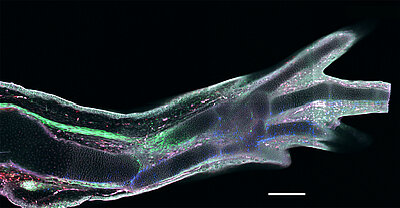Hand or arm? Chromatin holds the key
The axolotl Ambystoma mexicanum is famously able to regenerate limbs and many of its organs. Remarkably, the regenerated organs are also fully functional. To achieve this feat, the regenerating structures must “know” their position within the axolotl body: When an axolotl loses a limb at the level of its hand, it regenerates only the hand, however, when it loses the limb at the level of its shoulder, the animal regrows the upper and lower arm as well as the hand. But how do cells know where they are located and which body parts to regrow? In their new study, Elly Tanaka and her group at the Institute of Molecular Biology (IMBA) of the Austrian Academy of Sciences, including first authors Akane Kawaguchi and Jingkui Wang – also affiliated with the Research Institute of Molecular Pathology (IMP) - show that “stop signals” decorating genes allow axolotl cells to trigger the correct regeneration program.
Cells in the axolotl limb not only know where they are located, but also “remember” this positional information when transplanted into a new environment: When hand cells are transplanted into the upper arm, they still only regenerate the hand. Therefore, the Tanaka group asked how positional information is encoded in connective tissue cells before regeneration is triggered, and how the cells react once regeneration starts.
To understand more deeply how genes required for regeneration are regulated, the researchers studied chromatin. Chromatin proteins associate with DNA to regulate the activity of genes, and differences in chromatin are, for example, responsible for the difference between neurons and blood cells. Looking at chromatin in cells in the hand versus the upper arm, the researchers noted a striking difference, even when no regeneration was occurring: In the upper arm, genes that induce the formation of the hand are decorated with chromatin “stop” signals, while genes that induce the formation of the upper arm are not decorated with stop signals. In the hand, genes that induce hand formation are also not marked with stop signals.
When regeneration is triggered, these differences in chromatin are key for only regrowing the correct structures: In the upper arm, the strong stop signal on hand genes prevents the start of the “hand program”, and the upper arm regrows first. In the hand, no stop signals decorate the hand genes, therefore the “hand program” launches and the hand regrows. Meanwhile, the competition between genes ensures that hand genes block the growth of upper arm structures at the hand level. “By analyzing chromatin, we were able to identify chromatin modifications as a main memory mark, determining positional information in the axolotl limb”, Tanaka summarizes.
